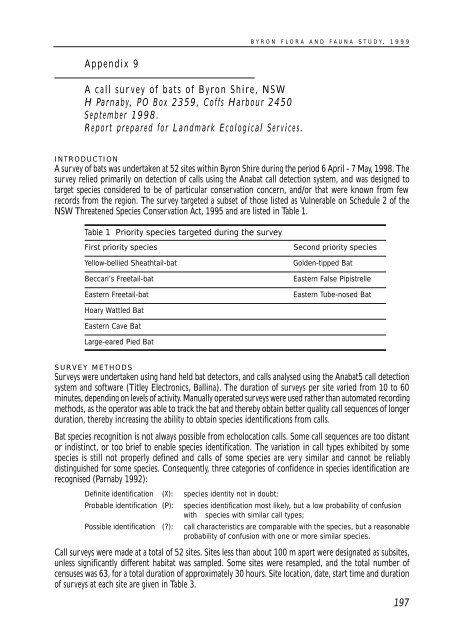Byron Flora and Fauna Study 1999 - Byron Shire Council
Byron Flora and Fauna Study 1999 - Byron Shire Council
Byron Flora and Fauna Study 1999 - Byron Shire Council
You also want an ePaper? Increase the reach of your titles
YUMPU automatically turns print PDFs into web optimized ePapers that Google loves.
BYRON FLORA AND FAUNA STUDY, <strong>1999</strong><br />
Appendix 9<br />
A call survey of bats of <strong>Byron</strong> <strong>Shire</strong>, NSW<br />
H Parnaby, PO Box 2359, Coffs Harbour 2450<br />
September 1998.<br />
Report prepared for L<strong>and</strong>mark Ecological Services.<br />
INTRODUCTION<br />
A survey of bats was undertaken at 52 sites within <strong>Byron</strong> <strong>Shire</strong> during the period 6 April - 7 May, 1998. The<br />
survey relied primarily on detection of calls using the Anabat call detection system, <strong>and</strong> was designed to<br />
target species considered to be of particular conservation concern, <strong>and</strong>/or that were known from few<br />
records from the region. The survey targeted a subset of those listed as Vulnerable on Schedule 2 of the<br />
NSW Threatened Species Conservation Act, 1995 <strong>and</strong> are listed in Table 1.<br />
Table 1 Priority species targeted during the survey<br />
First priority species<br />
Yellow-bellied Sheathtail-bat<br />
Beccari’s Freetail-bat<br />
Eastern Freetail-bat<br />
Second priority species<br />
Golden-tipped Bat<br />
Eastern False Pipistrelle<br />
Eastern Tube-nosed Bat<br />
Hoary Wattled Bat<br />
Eastern Cave Bat<br />
Large-eared Pied Bat<br />
SURVEY METHODS<br />
Surveys were undertaken using h<strong>and</strong> held bat detectors, <strong>and</strong> calls analysed using the Anabat5 call detection<br />
system <strong>and</strong> software (Titley Electronics, Ballina). The duration of surveys per site varied from 10 to 60<br />
minutes, depending on levels of activity. Manually operated surveys were used rather than automated recording<br />
methods, as the operator was able to track the bat <strong>and</strong> thereby obtain better quality call sequences of longer<br />
duration, thereby increasing the ability to obtain species identifications from calls.<br />
Bat species recognition is not always possible from echolocation calls. Some call sequences are too distant<br />
or indistinct, or too brief to enable species identification. The variation in call types exhibited by some<br />
species is still not properly defined <strong>and</strong> calls of some species are very similar <strong>and</strong> cannot be reliably<br />
distinguished for some species. Consequently, three categories of confidence in species identification are<br />
recognised (Parnaby 1992):<br />
Definite identification (X): species identity not in doubt;<br />
Probable identification (P): species identification most likely, but a low probability of confusion<br />
with species with similar call types;<br />
Possible identification (): call characteristics are comparable with the species, but a reasonable<br />
probability of confusion with one or more similar species.<br />
Call surveys were made at a total of 52 sites. Sites less than about 100 m apart were designated as subsites,<br />
unless significantly different habitat was sampled. Some sites were resampled, <strong>and</strong> the total number of<br />
censuses was 63, for a total duration of approximately 30 hours. Site location, date, start time <strong>and</strong> duration<br />
of surveys at each site are given in Table 3.<br />
197

















